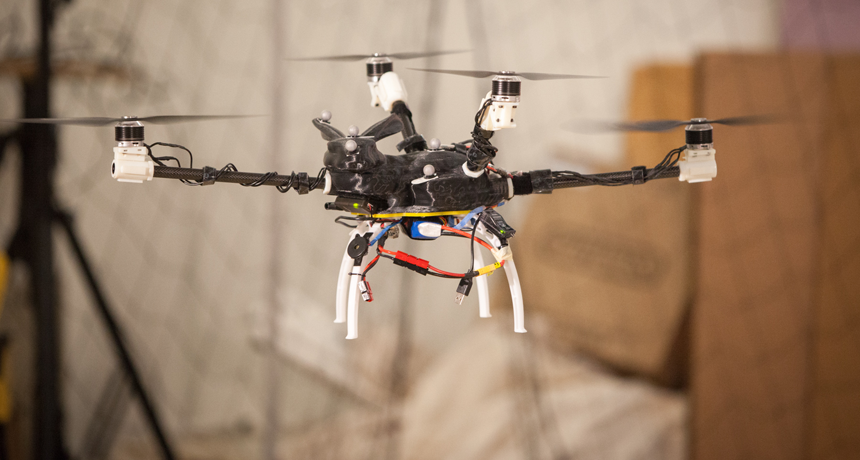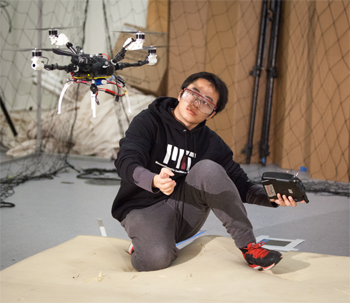Build the drone of your dreams
A new design system helps users build their own customized flying machines

This closeup of the bunnycopter shows its rotors, at different heights. A new computer program from MIT makes it possible to design and “test” such a drone before building it.
Jason Dorfman, MIT CSAIL
Drones zoom around almost everywhere these days. Farmers use them to monitor crops. Scientists use them to study hostile places, such as the inside of a volcano. Others fly them as a hobby. But drones of the future may not look like today’s models. But how well will such novel vehicles perform? Engineers at the Massachusetts Institute of Technology, in Cambridge, have created a new computer program that lets users design their own flying machines – and then pretest them.
The team debuted details of the program, last month, at an international meeting in Macao, China.
Many personal drones are some style of multicopter – a flying machine with spinning propellers. Quadcopters have four. Hexacopters have six. Yet “there are plenty of cases in which standard quadcopters and hexacopters might not be the best solution for a given task,” notes Tao Du. “There are only a small range of options for drones that you can buy,” points out this MIT graduate student who worked on the new program.
The system from Du’s team is the ultimate in do-it-yourself. It lets people pick the size, shape and structure that best fits their needs. Such an approach increases the shapes, styles and sizes of drones that users can fly and what they can do with them. And the designers don’t need to be experts in physics to do it.
Multicopters use their propellers to turn or go up and down. But the ones available to consumers can’t fit every need. For example, a scientist who wants to attach a special camera may find that the drone’s propellers block its view. Or, a drone might need to carry an object with an irregular shape. Say, for instance, you wanted a drone to carry an egg. With an off-the-shelf model, you’d have to rig up something that might destabilize it and cause it to crash. But if you design your own, you can build an egg carrier and choose a design that will keep it stable.
The MIT system could help in such situations. As they design a custom machine that actually flies, DIY-ers must consider a number of questions. What happens when many propellers spin at once? How many parts can you add and still keep a drone lightweight enough to fly well? How much propeller power does the machine need to overcome gravity? (Gravity is the force that is always tugging downward on the drone — and everything else.)
What makes it special
At the heart of MIT’s drone-design system is a new computer program. It helps the user select a shape that will function well. It also helps the user decide which ways the vehicle will fly. The program also runs virtual tests of the design to make sure it is not likely to crash in the real world.

Such calculations would be nearly impossible for an amateur to do alone, Du says.
Once a design is final, the system can produce a construction plan. It calculates which parts, such as rods and motors, the new drone will need. The parts could be made in a factory or produced on a 3-D printer. Then, all that’s left is for someone to put the pieces together. (For this part, Du cautions, adult supervision is required.)
Du and his team designed two drones to demonstrate their system. They called one a “bunnycopter” owing to its appearance. It uses four propellers of different sizes, set at different angles and different heights. The other pentacopter has five propellers, instead of four. It can carry more weight than most drones of its size. (See the videos below to watch these flying machines in action.)
The new software also can help designers decide how much power they’ll need. Drones run on batteries. But batteries are heavy. If you try to increase a drone’s flight time by adding more batteries, you also add more weight. And more weight means you need more power. It’s a feature that Mihir Garimella really appreciates. This 17-year-old drone designer in Pittsburgh, Pa., builds drones to help in disaster areas.
A drone might be able to locate survivors after a disaster or help firefighters map a fire. First responders are the crews first dispatched to offer aid at the scene of some disaster. Mihir has spent a lot of time talking with them. And they want drones that can fly for at least 20 minutes and carry a thermal camera, which detects heat, he learned. Right now, most drones can fly for no more than 7 to 10 minutes, and carry little weight. So cameras might be too much for long-flying versions of today’s drones to ferry. But using a system like the one from MIT, the teen suspects, users could find a way to fit more or better batteries onto these coptors — to fly further and carry heavier payloads. He’s certainly interested in getting a chance to try it.
He sees the new system as a good step forward in the visual design and computer testing of drones with specialized functions. “You can see what design would be best,” Mihir says. “I think it’s definitely a huge improvement over what we have now, which is nothing.”
Despite his young age, this teen placed second in robotics and intelligent machines at the 2015 Intel International Science & Engineering Fair. And at age 14, he placed first in the engineering category at the Broadcom MASTERS competition. Both are programs of the Society for Science & the Public (which also publishes this magazine). And the teen won first place in the 2014 Google Science Fair for his drone design for first responders.
MIT’s new drone-design system is not available just yet. But Du already sees ways to make its software better. Right now, it determines whether or not a design will work. In the future, it might also be able to recommend different options for where to put a rotor and highlight the pros and cons of different approaches.
“We are very eager for other researchers to build on this work and hopefully make drone-design even more accessible to non-experts,” says Du.
Garimella can’t wait to get started. “This is something I would like to have and would like to start using.”







